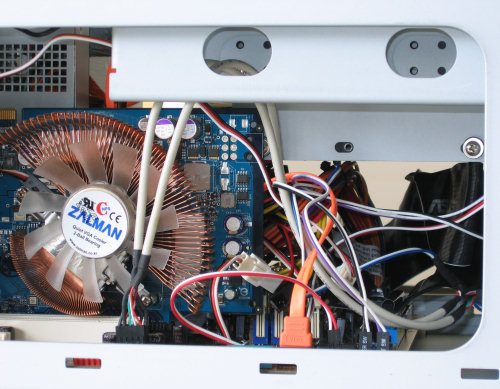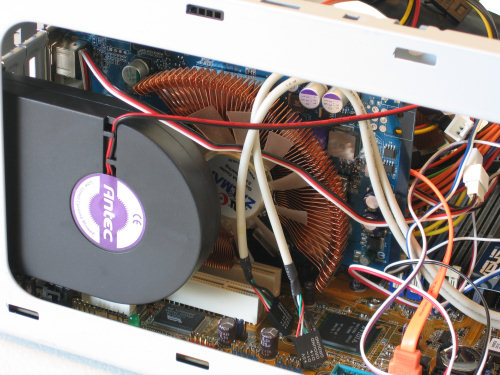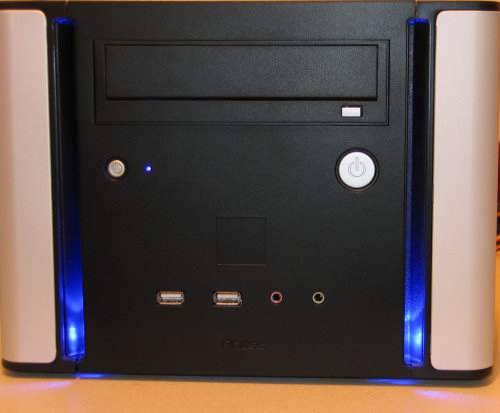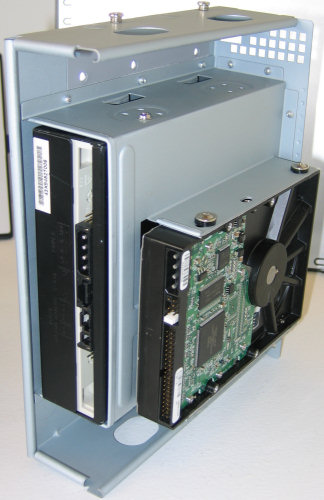Micro-ATX Cases - Shoebox Showdown
by Joshua Buss on January 2, 2007 12:40 PM EST- Posted in
- Cases/Cooling/PSUs
Antec Aria - Interior Cont'd
As with many SFF cases, the drive cage has to be prepared before being put back into the rest of the system. One hard drive fits underneath the optical cage, and two others can hang vertically from either side, only mounted with three screws on one side of the drive. Acoustic absorbing material is in between the vertical drives and the metal, and soft grommets are provided for the single horizontal 3.5" bay.
We had to remove the custom tray cover of our MSI CD burner, but the drive's bezel had to remain so the stealthy cover on the front of the case operated the eject button properly. Getting an SATA (or IDE) cable into the optical drive was a little tricky, but we managed thanks to the ability to hold the whole cage at a half-way open position.
A few more shots of the completed build give a good idea of how cramped things can get in a miniscule case, even if it is well designed.

The right side looks quite a bit better, giving a glimmer of hope to people hoping to put more elaborate cooling systems inside the Aria, as long as the vertical hard drives are omitted.

Antec includes a variable speed blower fan which we installed in the last open expansion bay to help the computer keep up with the moderately high cooling demands from our test bed.

Finally, with the test bed up and running, we could capture the effects of the power and HDD activity LEDs with a slower shutter speed, and this is what we got.

In many ways, the Antec Aria reminds us a lot of the typical Shuttle SFF systems, only it's a bit wider in order to accommodate a micro-ATX motherboard. The final price plus motherboard is lower than what you would pay for an SFF case, and you will be able to upgrade the motherboard in the future. While the case does offer more in the way of expansion options than most SFFs, we would be very hesitant to max out this particular design with three hard drives and four expansion cards. In a more moderate configuration, however, the case works well overall.
As with many SFF cases, the drive cage has to be prepared before being put back into the rest of the system. One hard drive fits underneath the optical cage, and two others can hang vertically from either side, only mounted with three screws on one side of the drive. Acoustic absorbing material is in between the vertical drives and the metal, and soft grommets are provided for the single horizontal 3.5" bay.
 |
| Click to enlarge |
We had to remove the custom tray cover of our MSI CD burner, but the drive's bezel had to remain so the stealthy cover on the front of the case operated the eject button properly. Getting an SATA (or IDE) cable into the optical drive was a little tricky, but we managed thanks to the ability to hold the whole cage at a half-way open position.
 |
| Click to enlarge |
A few more shots of the completed build give a good idea of how cramped things can get in a miniscule case, even if it is well designed.

The right side looks quite a bit better, giving a glimmer of hope to people hoping to put more elaborate cooling systems inside the Aria, as long as the vertical hard drives are omitted.

Antec includes a variable speed blower fan which we installed in the last open expansion bay to help the computer keep up with the moderately high cooling demands from our test bed.

Finally, with the test bed up and running, we could capture the effects of the power and HDD activity LEDs with a slower shutter speed, and this is what we got.

In many ways, the Antec Aria reminds us a lot of the typical Shuttle SFF systems, only it's a bit wider in order to accommodate a micro-ATX motherboard. The final price plus motherboard is lower than what you would pay for an SFF case, and you will be able to upgrade the motherboard in the future. While the case does offer more in the way of expansion options than most SFFs, we would be very hesitant to max out this particular design with three hard drives and four expansion cards. In a more moderate configuration, however, the case works well overall.










37 Comments
View All Comments
chucky2 - Tuesday, January 2, 2007 - link
:) Just asking...AlexWade - Tuesday, January 2, 2007 - link
Dear Anandtech staff:Please do more case reviews.
Signed,
Everyone
microAmp - Tuesday, January 2, 2007 - link
I'd like to see them do a review using video instead of text & pictures. I saw one other website do that and it's make a world of difference. Wish I could remember what site it was. :(JoshuaBuss - Tuesday, January 2, 2007 - link
Besides placing an excruciating load on the web servers, I think highly-detailed pictures are better than videos at least in terms of seeing exactly how things look. It's hard to get colors just right in videos, and resolution is normally low enough that some fine details are lost.. I can see where you're coming from though and we'll definitely consider it.. actually seeing things in motion can help get a better feel for some things.mino - Thursday, January 4, 2007 - link
Maybe host them on YouTube ? and consider them just a bonus to regular review...JoshuaBuss - Tuesday, January 2, 2007 - link
Copy that.. ;)In all seriousness, you can expect this section to get a lot hotter soon.. I just finished my last semester of coursework.. w00t.
SonixSquad - Wednesday, September 7, 2011 - link
Just wanted to post my experience having built my girlfriend a system about 5 years ago using the Antec Aria case.I remember it being a pain as it was so cramped and my first (and only) sff build but I got there and it was adequate. I managed to install the board without removing the PSU.
Once I started to monitor temps (was only using stock cpu cooler at the time) I realised it would need some sort of additional cooling intake and the supplied blower was a bit too loud for our liking.
Eventually I found the best air intake solution (without actually modding the case) was to just put a 120mm fan sitting next to the graphics card pulling air in from the rear.
Anyway, back to today 2011 and she still likes the case but the system needs an upgrade so I was looking at parts and having come across this article and seen the Zalman in there snugly fitting with a few mm clear of the PSU I decided to get the newer Zalman CNPS8000A which is low profile and supposedly quiet. I'll post back if it doesn't fit but I think I am going to have to remove the PSU this time around as this cooler needs to be fitted via backplate so it will have to go on before the board is in the case.
This time round she is getting an i3 2100 cpu which should run a lot cooler than the last AMD x2 one and so I'm hoping it will run a lot quieter aswell.
My criticisms about the case would be the same as noted by others. Very cramped and with a lack of decent routing the air circulation is bad. I would have appreciated some thought given to front air intake even if they didn't supply a fan but just somewhere to put one.
Also the PSU only comes with one SATA connector so I will have to get a molex to sata converter so I can power 2 sata devices.I also had some issues with the front audio inputs, at some point they stopped working properly and I still don't know why.